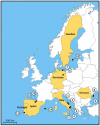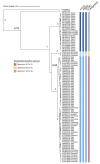Molecular Characterization of Anopheles algeriensis Theobald, 1903 (Diptera: Culicidae) Populations from Europe
- PMID: 36145422
- PMCID: PMC9505642
- DOI: 10.3390/pathogens11090990
Molecular Characterization of Anopheles algeriensis Theobald, 1903 (Diptera: Culicidae) Populations from Europe
Abstract
Anopheles algeriensis Theobald, 1903, considered a competent vector of Plasmodium parasites, is a mosquito species widely distributed in the Mediterranean area but rare in Northern and Central Europe. The disappearance of its suitable breeding sites in Italy is having a detrimental effect on the occurrence of this species once common along the Southern coasts and on the islands. Recently, molecular investigations have renewed interest in this species, highlighting a genetic heterogeneity among European populations. In this study, An. algeriensis populations from Italy, Germany, Romania, and Sweden were analyzed by molecular typing of the intergenic transcribed spacer 2 (ITS2). The mitochondrial cytochrome c oxidase subunit I (COI) was also analyzed from specimens collected in Southern Italy. With the aim of investigating the population structure of this species, the obtained data were compared to all publicly available ITS2 and COI sequences of An. algeriensis, adding specimens from Spain and Portugal. The analyses of both markers indicate a split between Iberian populations (Spain for ITS2 and Spain/Portugal for COI) and those from the rest of Europe, revealing two cryptic species. The analysis of the COI barcode revealed a third clade representing a cryptic species present in Danube Delta (Romania). The high levels of genetic divergence among the clades of An. algeriensis indicate that this taxon represents a species complex, potentially harboring several distinct cryptic species.
Keywords: Anopheles algeriensis; barcoding; cryptic species; intergenic transcribed spacer 2; mitochondrial cytochrome c oxidase subunit I; phylogenetic analysis.
Conflict of interest statement
The authors declare no conflict of interest. The funders had no role in the design of the study, in the collection, analyses, or interpretation of data, in the writing of the manuscript, or in the decision to publish the results.
Figures




Similar articles
-
Pilot longitudinal mosquito surveillance study in the Danube Delta Biosphere Reserve and the first reports of Anopheles algeriensis Theobald, 1903 and Aedes hungaricus Mihályi, 1955 for Romania.Parasit Vectors. 2016 Apr 11;9:196. doi: 10.1186/s13071-016-1484-7. Parasit Vectors. 2016. PMID: 27066827 Free PMC article.
-
Further reports of Anopheles algeriensis Theobald, 1903 (Diptera: Culicidae) in Germany, with evidence of local mass development.Parasitol Res. 2018 Aug;117(8):2689-2696. doi: 10.1007/s00436-018-5938-z. Epub 2018 May 26. Parasitol Res. 2018. PMID: 29804195
-
Molecular characterization of Anopheline (Diptera: Culicidae) mosquitoes from eight geographical locations of Sri Lanka.Malar J. 2017 Jun 2;16(1):234. doi: 10.1186/s12936-017-1876-y. Malar J. 2017. PMID: 28578667 Free PMC article.
-
Molecular Characterization of Mosquito Diversity in the Balearic Islands.J Med Entomol. 2021 Mar 12;58(2):608-615. doi: 10.1093/jme/tjaa217. J Med Entomol. 2021. PMID: 33098292
-
DNA barcoding mosquitoes: advice for potential prospectors.Parasitology. 2018 Apr;145(5):622-633. doi: 10.1017/S0031182018000343. Epub 2018 Mar 22. Parasitology. 2018. PMID: 29564995 Review.
Cited by
-
Anopheles sacharovi in Italy: first record of the historical malaria vector after over 50 years.Parasit Vectors. 2024 Apr 10;17(1):182. doi: 10.1186/s13071-024-06252-2. Parasit Vectors. 2024. PMID: 38600589 Free PMC article.
References
-
- Gubler D.J. The Global Threat of Emergent/Re-emergent Vector-Borne Diseases. In: Atkinson P.W., editor. Vector Biology, Ecology and Control. Springer; Dordrecht, The Netherlands: 2010. - DOI
-
- WHO World Malaria Report 2021. [(accessed on 10 June 2022)]. Available online: https://www.who.int/publications/i/item/9789240040496.
-
- European Centre for Disease Prevention and Control . Multiple Reports of Locally-Acquired Malaria Infections in the EU—20 September 2017. ECDC; Stockholm, Sweden: 2017.
-
- NPHO . Epidemiological Surveillance Report Malaria in Greece. NPHO; Athens, Greece: 2021. Malaria Report.
-
- Boccolini D., Menegon M., Di Luca M., Toma L., Severini F., Marucci G., D’Amato S., Caraglia A., Maraglino F.P., Rezza G., et al. Non-imported malaria in Italy: Paradigmatic approaches and public health implications following an unusual cluster of cases in 2017. BMC Public Health. 2020;20:857. doi: 10.1186/s12889-020-08748-9. - DOI - PMC - PubMed
LinkOut - more resources
Full Text Sources

